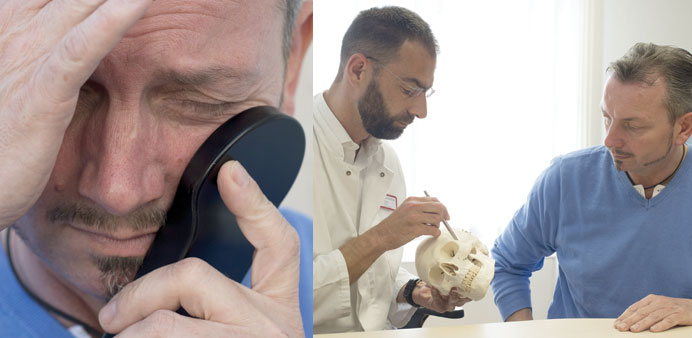IN USE: Cluster headache sufferer Frank Eward demonstrating the use of the remote control device that activates an implant against his headaches. Right: Frank Eward, right, with head physician Andreas Boeger, who is pointing to the position on the skull where an implant against cluster headaches would reside.
By Timo Lindemann
Frank Ewald inflicts pain on himself by remote control nearly every day. It is not enjoyable but it helps him avoid even worse pain, the kind of suffering that has led others to attempt suicide.
Ewald suffers from cluster headaches.
“A real nightmare. Migraines are a piece of cake compared to this. It’s so bad that many patients lose hope,” says head physician Andreas Boeger at the Clinic for Pain Medicine at the Red Cross Hospital in Kassel.
That is why they are also called suicide headaches.
“You do not get used to them because the pain is so strong,” says Boeger, who is a board member of the Professional Association of Physicians in Pain and Palliative Medicine and Medicine in Germany (BVSD).
This massive pain can be shut down and largely pushed back — at least for the 49-year-old Ewald.
“The device causes pain but not nearly as severe as the clusters. I always have it with me,” says the Lohfelden native.
What are cluster headaches like?
Most of the patients get the attacks at night while sleeping. They are strong, one-sided, stinging headaches. Symptoms are — unlike for migraine sufferers — a runny nose, drooping eyelids and pupil constriction. Until now there have been very few treatment options for cluster headaches.
“No one knows yet how it happens,” says Boeger.
The Kassel clinic treats 250 cluster patients, making it the largest such institution in Germany.
And how does the treatment work?
First, a chip is implanted at a bundle of nerves in the upper jaw in the oral cavity. The chip is activated via induction with the remote control.
“The bundle of nerves is responsible for the transmission of pain. You can disrupt the attacks there and also suppress them,” says Boeger.
Including implantation, the sensor costs about 35,000 euros (38,700 dollars). The costs are covered by insurance, though Boeger says the sensor is not for everybody.
Cluster headaches currently are not curable. The BVSD says about 0.1 per cent of the people in Germany suffer from them — or about as many as sufferers of multiple sclerosis.
“It is important to me to pass information about clusters to the people,” says Boeger.
He says many people have been wrongly diagnosed because it takes about seven years before it can be correctly diagnosed.
Ewald underwent the operation two years ago.
“I have suffered from clusters since I was 18 years old. The diagnosis did not come until 10 years later,” he says.
“Clusters controlled my life.”
Now he uses the device three or four times a week after work for between 10 and 20 minutes.
“After the implantation I was pain free for 17 months. It’s absolutely an improvement in quality of life. We took trips with the family, also to the United States. That wouldn’t have been possible otherwise,” Ewald says. —DPA



